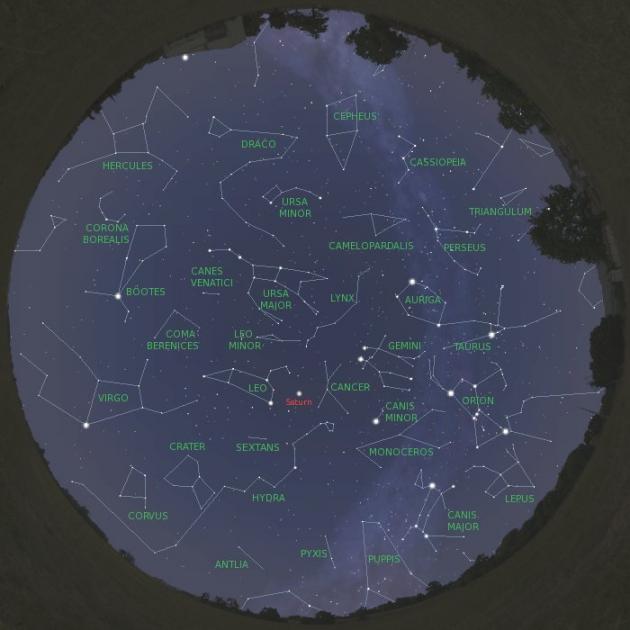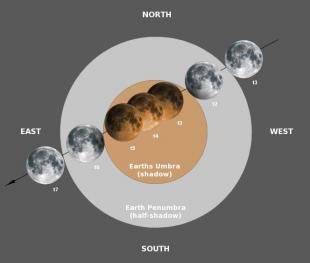- News / Thoughts
- Astronomy Guide
- On This Day
- Reviews
- Bookstore
Astronomical Events for March 2007
02/28/2007On the beginning of March 2007, residents of Europe and Africa have an interesting show - the total eclipse of the Moon. During that eclipse, our natural satellite will, for a couple of hours, distinctively change it's color into brown-red.
On the planet front, we still have Venus and Saturn to gaze upon, and near the end of month, we'll have close encounter with one asteroid, which will whizz only 0.3 AU from Earth.
O

Evening sky for the middle of March 2007. at 9:30 PM. The map is valid for northern hemisphere, especially positions near 45 degrees latitude.
The total eclipse of the Moon is definitively the main event of the month. Lots of amateur astronomers overjoyingly wait for it, but even other people tend to look upwards on this special occasion.
Simply said, total eclipse of the Moon occurs when our natural satellite is on the other side then the Sun (hence it's fully lit), and when it comes near enough to enter Earths shadow. Then we observe color change, as the Moon passes from it's usual light gray into shades of orange, red or even chocolate brown. It is hard to predetermine the intensity of color change for particular Moon eclipse.
o
O

Moon eclipse timings for March 2007.
This year we have two total Moon eclipses. The first one is on March 3, and is visible mainly from Europe and Africa, but residents of west Asia and northeast America can also see at least part of this celestial show. The second one is viewable on the other half of the Earth on August 28, thus seen in North and South America, East Asia and Australia.
Moon eclipse is easily viewed with unaided eye, so if weather conditions allow you, be sure to enjoy in this astronomical event. You can even use your camera to freeze this event in time.
o
O

Moon eclipse path
The event starts Saturday evening, on March 3rd, and finishes in the morning hours. The time line is as follows:
- t1 - 20:18 UT
- t2 - 21:30 UT
- t3 - 22:44 UT
- t4 - 23:20 UT
- t5 - 23:57 UT
- t6 - 01:11 UT
- t7 - 02:33 UT
Last month, Mercury has given us a little performance, but since then has skipped towards morning planets, so this month we're back with evening star Venus, and the ring bearer - Saturn. Saturn is especially well positioned this month, since it's viewable all night, and is almost as 70 degrees above horizon.
In March of every year, the Sun passes from southern to northern hemisphere, and that moment in time marks the beginning of new season. Thus the spring this year starts on March 21, at 00:07 UT.
Also at this time of year, we have to switch to summer time, and this year it can be a bit more complicated. As usual Europe switches to summer time on the last Sunday in March on 01:00 o'clock in the night. The USA has changed the time change to second Sunday in March, on 02:00 o'clock in the morning. So use this information to switch to your time from UT (Universal Time) used on this pages.
Near the end of month astronomy enthusiasts have another interesting event. Asteroid 2006 VV2, sized around 2km, will swing close to Earth, getting as near as 0.3 AU. It is expected it'll brighten to about 10th magnitude, so it'll be easily seen in telescopes. Although many asteroids can be seen each month, what makes this one interesting is that, getting so near Earth, it'll move quite fast among the stars. Hence the movement will be readily seen when watching it for only a few hours. The asteroid 2006 VV2 will be closest to Earth on March 30, when it'll be in the center of Leo constellation, heading south. You can start looking for it few days earlier on March 26, when it'll be near star Polaris. Although today modern methods and expensive equipment is used to detect asteroids and comets, by chasing this known asteroid, you'll get a feeling how it was done in the past.
To better plan your observing nights, here are Moon phases:
- Full Moon - March 3. 23:17 UT
- Last Quarter - March 12. 03:54 UT
- New Moon - March 19. 02:43 UT
- First Quarter - March 25. 18:16 UT